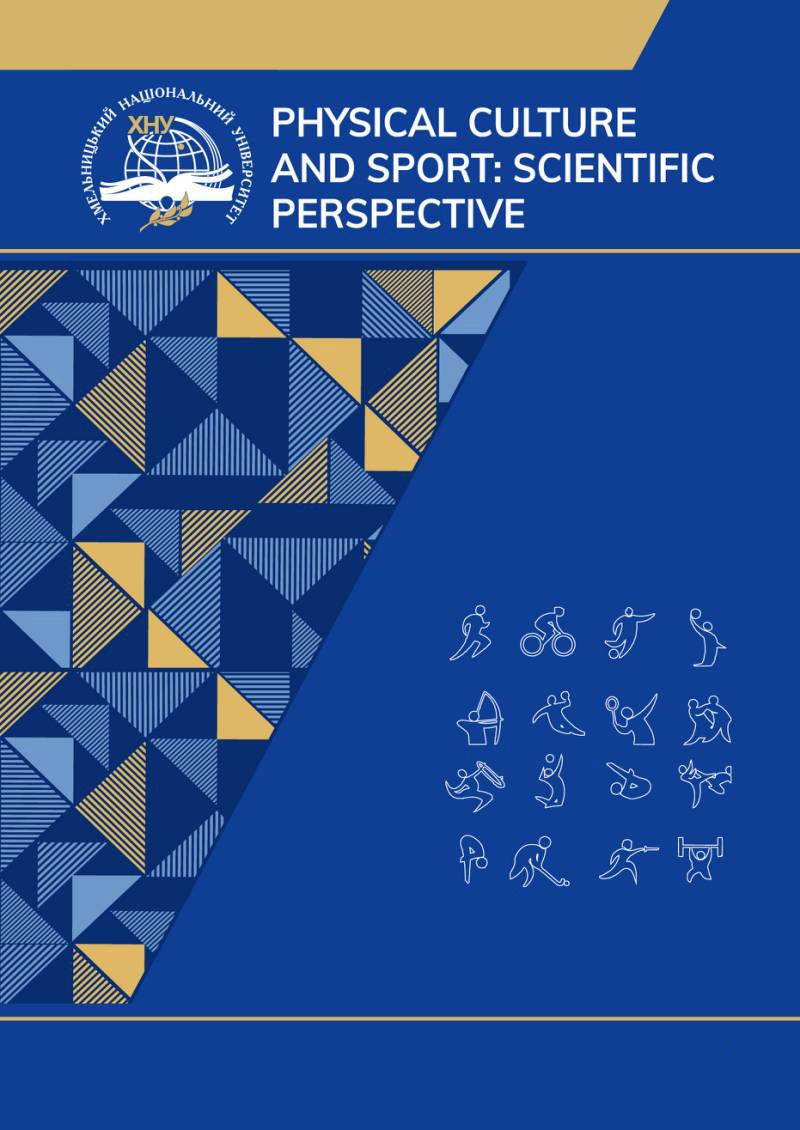MONITORING OF THE PSYCHOPHYSICAL CONDITION OF STUDENTS STUDYING IN THE SPECIALTY 017 PHYSICAL CULTURE AND SPORT
DOI:
https://doi.org/10.31891/pcs.2024.1.65Keywords:
nts of higher education of the first (bachelor) level, interoceptive awareness, the process of physical education, somatic lessonsAbstract
Taking into account the fact that in the modern conditions of the educational and training process of physical education and sports specialists, more and more time is devoted to online learning, the relevance of the development of interoceptive awareness only increases. Somatic classes are held both face-to-face and offline. The number of applicants depends on the qualifications of the teacher and the capacity of the audience. 1-3 academic groups can be present at one intramural somatic lesson. The number of participants in somatic online classes depends only on the software, i.e. much more (for example, for communication in the "Zoom" program, there can be up to 500 listeners).
The purpose of the study is to evaluate the "Not-Worrying" (the third domain of interoceptive awareness, MAIA-2ukr) of 1st-year students of the Faculty of Health, Physical Education and Sports of the Borys Grinchenko Kyiv metropolitan University. Material and methods — the scientific and methodological literature and available Internet sources on the chosen topic were analyzed in detail, as well as the indicators of the third domain of the MAIA-2ukr scale were evaluated and statistically worked out. 50 first-year students of the Faculty of Health, Physical Education and Sports participated in the study. As a result, new indicators of the Not-Worrying subscale, which assesses the tendency not to worry or not to experience emotional stress when experiencing pain or discomfort, were obtained for 1st-year students of the Faculty of Health, Physical Education and Sports of Borys Grinchenko Kyiv University, necessary for further analysis and synthesis of indicators of interoceptive awareness of higher education students of the first (bachelor) level. The obtained data indicate that a significant number of students - 22% are always upset when they feel physical pain; 24% quite often begin to worry that something is wrong if they feel any discomfort; 26%, noticing discomfort in their body, rarely worry about it; 28% can quite often keep calm and not worry when they feel discomfort or pain; 26%, experiencing discomfort or pain, quite rarely do not worry about it. Therefore, the process of preparing for physical education lessons needs corrections in view of the obtained indicators of the Not-Worrying subscale.
References
Bortnyk, k. (2020). The Feldenkrais method as an innovative tool for teaching the art of dance to students of theater high schools. Current issues of the humanities, 1(29), 216-221. (In Ukrainian).
Holovach I. (2023). Somatic lessons as a means of improving students' psychophysical condition. Physical Culture and Sport: Scientific Perspective, 2, 187–192. (In Ukrainian).
Holovach I., Biletska V., Tsykoza Y. (2023) Somatic lessons as a means of improving the psycho-physical state of students. Monitoring of the second domain MAIA-2ukr. Physical Culture and Sport: Scientific Perspective, № 3, 17-24. (In Ukrainian).
Pavlyuk, T. (2018). Somatic practices in modern ballroom choreography. Culture and modernity, 1, 97-102. (In Ukrainian).
Voloshchenko Y. (2023). Interoceptive awareness. verification of the adaptation of the Ukrainian version of the multidimensional assessment of interoceptive awareness (version 2) questionnaire among first-year students of Borys Grinchenko Kyiv University. Sports science and human health, 1(9), 68-90. (In Ukrainian).
Voloshchenko Y. (2022). Somatic movement education. Modern research methods: a systematic review. Sports science and human health, 2 (8), 22-51. (In Ukrainian).
Ahmadi, H., Adib, H., Selk-Ghaffari, M., Shafizad, M., Moradi, S., Madani, Z., ... & Mahmoodi, A. (2020). Comparison of the effects of the Feldenkrais method versus core stability exercise in the management of chronic low back pain: a randomised control trial. Clinical Rehabilitation, 34(12), 1449-1457.
Ashcroft, R. E. (2008). The declaration of Helsinki. The Oxford textbook of clinical research ethics, 141-148.
Ferentzi, E., Olaru, G., Geiger, M., Vig, L., Köteles, F., & Wilhelm, O. (2021). Examining the factor structure and validity of the multidimensional assessment of interoceptive awareness. Journal of Personality Assessment, 103(5), 675-684.
Fujino, H. (2019). Further validation of the Japanese version of the Multidimensional Assessment of Interoceptive Awareness. BMC Research Notes, 12, 1-6.
Machorrinho, J., Veiga, G., Fernandes, J., Mehling, W., & Marmeleira, J. (2019). Multidimensional assessment of interoceptive awareness: Psychometric properties of the Portuguese version. Perceptual and motor skills, 126(1), 87-105.
Mehling, W. E., Acree, M., Stewart, A., Silas, J., & Jones, A. (2018). The multidimensional assessment of interoceptive awareness, version 2 (MAIA-2). PloS one, 13(12), e0208034.
Montoya-Hurtado, O., Gómez-Jaramillo, N., Bermúdez-Jaimes, G., Correa-Ortiz, L., Cañón, S., Juárez-Vela, R., ... & Criado-Gutiérrez, J. (2023). Psychometric Properties of the Multidimensional Assessment of Interoceptive Awareness (MAIA) Questionnaire in Colombian University Students. Journal of Clinical Medicine, 12(8), 2937.
Paparo, S. A. (2021). Singing with awareness: A phenomenology of singers’ experience with the Feldenkrais Method. Research Studies in Music Education, 1321103X211020642.
Ranđelović, M., Jokic, B., & Purić, D. (2023). Are dimensions of interoceptive awareness the same for everyone? Serbian validation of MAIA-2 in samples with differing mind-body practice experience.
Multidimensional assessment of interoceptive awareness (MAIA), version 2, Ukrainian. (2022). Retrieved from https://osher.ucsf.edu/sites/osher.ucsf.edu/files/inline-files/MAIA-2-Ukrainian%5B2022%5D.pdf.





